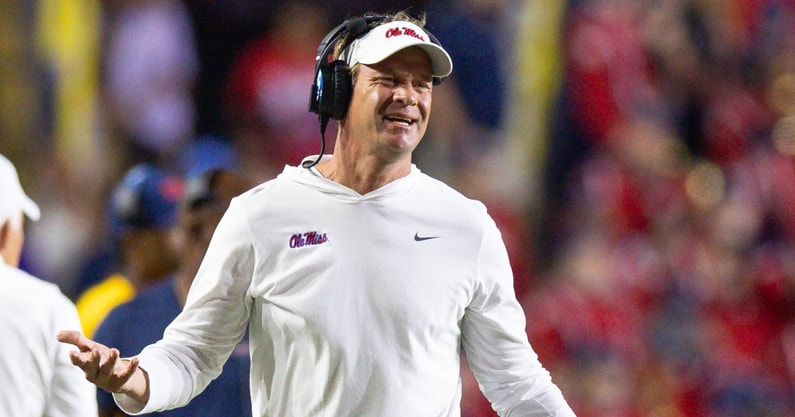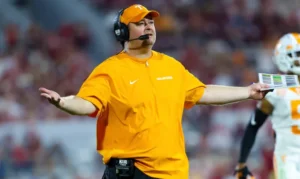
Field storming is a tradition as old as college football itself. Whether it’s after a monumental upset, a dramatic game-winner, or a season-defining victory, fans rushing the field has become a celebration of team success, creating iconic moments of pure emotion and chaos. But Lane Kiffin, the outspoken head coach of the Ole Miss Rebels, has taken aim at this tradition, labeling it the “worst tradition” in college football. His comments have ignited a wave of debate, with fans, players, and coaches alike weighing in on the practice’s merits and drawbacks.
Field storming, for all its celebratory nature, has sparked controversy over the years. What may seem like innocent fanfare can quickly turn dangerous, disruptive, and even harmful to the integrity of the game. Kiffin, known for his candid, and often controversial, opinions, has drawn attention to the growing concerns surrounding this tradition, questioning its place in a sport that prides itself on decorum and respect.
In this article, we’ll explore Kiffin’s criticism of field storming, delve into the broader context of college football traditions, and examine the consequences—both positive and negative—of a practice that has become a staple of many college football game days.
Lane Kiffin’s Critique: A Bold Stance
Lane Kiffin, the fiery and often polarizing head coach of Ole Miss, did not mince words when he expressed his disapproval of field storming. During a recent press conference, Kiffin was asked about his thoughts on the tradition, particularly after some high-profile examples of field storming following upset victories. His response was swift and unequivocal: he believes field storming is the “worst tradition” in college football.
“I just don’t understand it,” Kiffin said. “We’ve got a whole stadium full of people watching the game, and then the students come running onto the field like they’ve won a national championship when they beat a team they were supposed to beat. It’s dangerous, it’s disruptive, and it really diminishes the hard work and effort that goes into making these games happen. It’s an unsafe practice and frankly, it’s the worst tradition in college football.”
His words were met with mixed reactions, with some fans and pundits agreeing with his perspective, while others defended the tradition, arguing that it adds to the excitement and passion that make college football unique. However, Kiffin’s comments have certainly added fuel to an ongoing debate about whether field storming still has a place in today’s college football landscape.
The Tradition of Field Storming: A Brief History
To understand the weight of Kiffin’s criticism, it’s important to first examine the history of field storming in college football. The tradition of fans rushing onto the field after a big victory has been around for decades. In many cases, it’s a way for fans to express their sheer joy and elation following a victory, especially when their team has pulled off an upset or secured a significant achievement.
The practice began in the 1960s and 1970s, and while it was originally reserved for major upsets or bowl victories, it gradually spread across college campuses. Today, field storming is a common occurrence after dramatic wins, including those over highly-ranked opponents, division rivals, or during conference championship games. It’s seen as a communal celebration, where fans get the opportunity to share in the triumph with their team, often jumping and cheering alongside players and coaches.
For some, it’s the ultimate display of fan passion and the connection between a college community and its football team. For others, however, it has evolved into an unnecessary and often dangerous spectacle. While the tradition remains entrenched in college football culture, its risks and drawbacks have become harder to ignore, especially in an era where safety and security are paramount.
The Risks: Safety Concerns and Disruptions
Kiffin’s main argument against field storming centers around safety concerns. College football stadiums can hold tens of thousands of fans, and when those fans rush the field in a frenzy of excitement, the situation can quickly become chaotic. There have been numerous incidents in which players, coaches, and even fans have been injured in the aftermath of a field storming, from twisted ankles to more serious injuries.
One of the biggest safety concerns is the risk of trampling. When thousands of fans pour onto the field in a short span of time, the potential for individuals to get knocked over or injured is high. Players who are still on the field after the game, especially those who have suffered physical tolls during the contest, are at risk of being accidentally hurt by exuberant fans. Coaches are also vulnerable to being caught in the fray, as seen in instances where opposing coaches have been surrounded or even physically impacted by the surging crowd.
In 2019, during a game between the University of Tennessee and South Carolina, a fan stormed the field after the Volunteers’ dramatic victory, only to punch South Carolina coach Will Muschamp in the back. While this incident was isolated, it highlighted the potential for hostile or aggressive actions during field rushes. In a highly charged environment, emotions run high, and fan behavior can sometimes spiral out of control.
Aside from the safety issues, field storming can also disrupt the flow of post-game activities, such as team celebrations, media interviews, and official events. What should be a moment of reflection and appreciation for the effort and performance on the field is often derailed by the rush of fans flooding the field, making it difficult for coaches and players to interact with the media or properly acknowledge their fans.
Diminishing the Achievement?
Another point that Kiffin raised in his comments about field storming is the idea that the tradition has become somewhat diluted. What was once reserved for truly monumental upsets or hard-fought victories has now become commonplace after almost any big win, even if it’s over an inferior opponent or in a game that was expected to be won.
In today’s college football world, it’s not uncommon to see fans rush the field after a regular-season victory against a mid-tier opponent or a team that is considered underperforming. For Kiffin, this diminishes the significance of the win itself. When every victory—regardless of its magnitude—is met with a field storming, the tradition starts to lose its value, and the emotional weight of such a celebration is watered down.
“When you storm the field every time you beat a ranked team, what happens when you actually do something historic?” Kiffin asked. “The moment is lost. The impact isn’t as big anymore because the field is stormed every other week.”
This viewpoint reflects Kiffin’s frustration with the saturation of field storming and its shifting meaning over time. What was once a rare, exciting event has turned into an almost routine practice, which raises the question: does it still carry the same weight and excitement as it once did?
Field Storming in the Context of College Football’s Landscape
While Kiffin’s comments may have been seen as harsh by some, they bring up a larger issue about college football’s evolving landscape. As the sport grows in popularity and the business side of college football becomes more intertwined with the games themselves, traditions like field storming may no longer be as innocent or as meaningful as they once were. Increased media exposure and social media have also played a role in turning what used to be a spontaneous and organic event into a spectacle that is broadcast across the nation.
With NIL deals and the commercialization of college football, field storming is increasingly seen as a part of the overall entertainment value of the game, not just as a student-led expression of school spirit. It can be argued that, in some cases, fans storm the field because they feel it’s expected or because it enhances the drama of the broadcast, rather than because it’s a genuine celebration of the team’s victory.
In this context, Kiffin’s comments challenge the very notion of what college football traditions should represent. Are they meant to be pure, spontaneous expressions of fandom, or have they become performance pieces in a larger media spectacle?
The Future of Field Storming: Should it Be Banned?
As Kiffin’s remarks have sparked significant debate, some are calling for stricter regulations or even outright bans on field storming, citing safety concerns and its growing overuse. Schools and conferences could implement rules to discourage the practice, such as penalizing teams whose fans storm the field after routine victories. Others believe that fan behavior can be better managed through increased security measures or by encouraging alternative celebrations that do not involve rushing the field.
However, others argue that field storming is an intrinsic part of what makes college football special—the raw passion, the student involvement, and the unpredictable moments that can turn an ordinary victory into an unforgettable one. College football is about tradition, and field storming, for all its risks, remains a visceral expression of that tradition.
Lane Kiffin’s declaration that field storming is the “worst tradition” in college football has certainly sparked an important conversation about the role of traditions in the sport. While some argue that field storming is an exciting and necessary part of the college football experience, others, including Kiffin, see it as a dangerous, disruptive, and increasingly diluted practice.
The future of field storming remains uncertain. Whether it’s banned, regulated, or continues unabated, the debate surrounding its place in college football will undoubtedly shape the sport’s culture for years to come. But one thing is clear—field storming, for all its faults and flaws, will continue to be one of the most polarizing aspects of the game.
In the end, the question remains: is field storming a celebration of college football’s passionate fanbase, or is it a tradition that has outlived its usefulness in today’s modern game?





